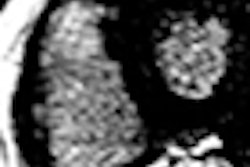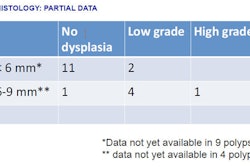CHICAGO - Contrast doses for CT angiography (CTA) are too high, but they can be lowered substantially with the right equipment and careful attention to technique, according to researchers from Charité University Medical School in Berlin. Obese patients will need more iodinated contrast than thin ones, but not as much they're getting now, the study concludes.
Dr. Alexander Lembke, Dr. Patrick Hein, and colleagues used 320-detector-row CT (Aquilion One, Toshiba America Medical Systems, Tustin, CA) and a tailored contrast dose to perform the exam with half of the recommended 70-cc dose.
In any case, the rule of thumb for coronary CTA contrast -- that injection of at least 10 seconds at 5 mL/sec is required for arterial enhancement, plus the time required to scan the heart -- does square with the manufacturer's dose recommendations for single-beat scanning. The recommended dose of 70 mL is too high, Lembke said on Tuesday at the RSNA meeting.
"There's a mismatch between the total contrast injection of 14 seconds and the scan time of less than one second," Lembke said. "Therefore, the question becomes -- with a specifically tailored contrast medium injection, can you reduce the volume of contrast material."
The study examined 60 patients who were randomly assigned to either a dedicated low-volume (35 mL injected at 7.5 mL/sec; group A, n = 30) or a standard-volume (70 mL injected at 5.0 mL/sec; group B, n=30) contrast media (Ultravist, Bayer HealthCare Pharmaceuticals, Wayne, NJ) injection protocol.
All patients had indications for noninvasive coronary angiography, with body weight ranging from 60-80 kg, anterior-posterior chest diameter 22-28 cm, regular sinus rhythm with a heart rate ≤ 65 bpm, and no signs of congestive heart failure, Lembke said. "All patients had normal cardiac function as determined by transthoracic echocardiography," he added. All patients received beta-blockers before imaging.
Patients were examined with a standardized, prospectively ECG-triggered single-beat nonspiral CT scan technique (100 kV, 260-580 mA, and adapted according to the chest diameter). Collimation was 0.5 mm.
Images were acquired at 75% of the RR interval (350 msec plus 150 msec "padding") to compensate for any heart rate variability.
Bolus tracking was used to start scanning based on a region of interest in the left ventricle of < 300 HU. Both groups were compared with respect to enhancement within the main pulmonary artery (PA), left atrium (LA), left ventricle (LV), ascending aorta (AA), descending aorta (DA), and near the origin of left and right coronary artery (LCA and RCA, respectively).
"Both groups were comparable in age, gender, body habitus, and cardiac function, and all datasets had diagnostic image quality with adequate opacification of the pulmonary artery tree," Lembke said. No extravasation or other problems were observed.
The mean enhancement values were significantly lower (p < 0.05) for group A compared with group B for the pulmonary and left anterior descending arteries as well as the left ventricle, and the clinical images show obvious differences between the two groups in these vessels, Lembke said. However, there were only minimal (insignificant) differences for mean enhancement values for the ascending aorta, descending aorta, left circumflex, and right coronary arteries.
Arterial contrast enhancement
|
||||||||||||||||||||||||||||||||
| Chart shows comparable contrast enhancement levels (in HU) in the normal contrast dose group (B) versus the low-contrast-dose group (A) in 60 patients. No significant differences (n.s.) between the groups were seen in most vessels. |
"In selected patients, the use of snapshotlike data acquisition combined with a wide area detector CT system and a dedicated contrast media injection protocol allows for a large reduction in contrast volume that has to be injected," Lembke said.
An audience member asked if the method generated adequate views of the left atrium and pulmonary veins, considering the lower HU values for these regions in the low-contrast patients.
"I'm not sure -- maybe you will have to choose a different timing to visualize the pulmonary veins," Lembke said.
An audience member from Cleveland wondered if the method were really practical for most American patients, who tend to be heavier. Lembke estimated that perhaps an additional 10 mL of contrast would be needed for patients > 80 kg, and an additional 20 mL for patients > 100 kg.
By Eric Barnes
AuntMinnie.com staff writer
December 2, 2009
Related Reading
Dual-source CTA turns in mixed results for coronary stenoses, July 30, 2009
Coronary artery calcium independently predicts risk in CAD patients, July 29, 2009
Coronary CTA beats calcium scoring for short-term prognosis, August 14, 2009
Coronary CTA aids some asymptomatic patients, August 27, 2007
Copyright © 2009 AuntMinnie.com



















